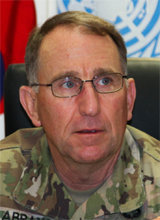USFK Commander vows to enhance missile defense against the North
USFK Commander vows to enhance missile defense against the North
Posted March. 12, 2021 07:40,
Updated March. 12, 2021 07:40


Gen. Robert B. Abrams (pictured), the commander of ROK-US Combined Forces and the United States Forces Korea, said the USFK’s intercept capabilities against North Korean missiles will be dramatically improved within this year.
His remarks are apparently aimed at stressing the coordination effort by the U.S. allies over the Joe Biden administration’s policy towards Pyongyang and Beijing while making a watertight effort to readily respond to potential nuclear and missile threats from the North with the imminent visits of State Secretary Antony Blinken and Defense Secretary Lloyd Austin and the first 2+2 foreign ministerial meeting with Washington in five years being slated on March 17 and 18, respectively.
Attending a virtual hearing hosted by the House Armed Service Committee on Wednesday (local time), Commander Robert Abrams said one of the three specific capabilities currently developed by the MDA (Missile Defense Agency) has already been deployed in South Korea, adding, “The other two will be deployed this year to dramatically improve our ballistic missile defense capabilities.”
He also said that the defense capabilities of the combined forces remain highly staunch, stressing how the U.S. Congress is strongly supporting the Joint Emergent Operational Need (JEON), which was proposed by the USFK several years ago. The USFK explained that what the commander was referring to was an on-going THAAD upgrade rather than deployment of new interceptor weapons.
The USFK is pushing for a three-level upgrade for the THAAD capabilities in Seongju and the PAC-3 MSE missile system in major strategic points in the face of the ever growing sophistication of North Korean missile threats such as the newly revealed weapons aimed at striking the South such as the “North Korean Iskander” missile system and SLBMs. It appears that the Joint Emergent Operational Need is also part of that process.
Under Level 1, the launching pad and the control station/radar of the THAAD system are separately deployed and remotely fired, and Level 2 entails remotely firing Patriot missiles through THAAD radars. This can expand the interception range of the THAAD system and Patriot missiles and cut response time as well. Level 3 is to achieve single interoperability between THAAD and Patriot systems, which have different intercept altitudes and ranges. This operational integration is expected to help prevent dead angles and maximize the efficiency of intercept.
“Our goal is to build an intercept system both quickly and thoroughly to counter a scenario where the North fires a mix of different range missiles from varied altitudes including the new weapons for the South and shorter ranged missiles such as the KN-26 and medium-range missiles such as Hwasong-12,” a military official explained. According to a fiscal year 2021 budget, which was disclosed by the MDA last year, Level 1 upgrade was finalized in late 2019, with Level 2 and 3 being expected to be finished in the first half of 2021. Another official from the military authorities said Commander Abrams made it clear that the THAAD upgrade will be completed this year.
Some experts are concerned about potential backlash from Beijing. They claim that China, which has accused THAAD of targeting Beijing and put pressure on Seoul, might consider Mr. Abrams’ remarks as provocation with an impending 2+2 foreign ministerial meeting between Seoul and Washington intensifying tensions.
Sang-Ho Yun ysh1005@donga.com







